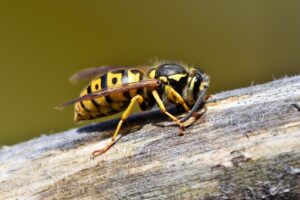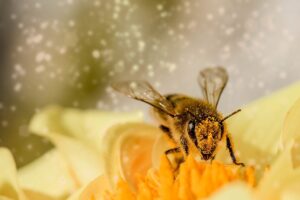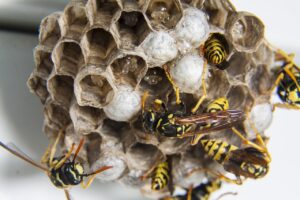We are now Adventure Pest and Wildlife! Go to our new site here: adventurepest.com
We treat for bees and wasps! It can be scary to have bees and wasps around your home, especially if you have children or are allergic to stings! We can absolutely treat for them, and there are some important things to know!
 Did you know wasps can forage for up to 1.5 miles for food? It’s important to know the location of the hive so we can treat it. There are wasp bait stations that we can use to help. Wasps are attracted to protein, so if your neighbor has dog droppings on their lawn, you might get some wasps lingering around their yard and into yours. Wasps eat the protein, Including the dog poop. It’s important to keep all pet food inside in airtight containers, and to pick up any pet droppings outside.
Did you know wasps can forage for up to 1.5 miles for food? It’s important to know the location of the hive so we can treat it. There are wasp bait stations that we can use to help. Wasps are attracted to protein, so if your neighbor has dog droppings on their lawn, you might get some wasps lingering around their yard and into yours. Wasps eat the protein, Including the dog poop. It’s important to keep all pet food inside in airtight containers, and to pick up any pet droppings outside.
Will I get stung?
If you have bees or wasps around you, don’t swat at them or act aggressive. Doing so may actually make them feel threatened and they will be more likely to sting. The best thing to do is remain still and calmly move out of the way.
If you do get stung, use something flat like a credit card to swipe the stinger out of your skin. Do not squeeze the stinger, or use tweezers to remove it as this may push additional venom into your body. You may even see some white squiggly material on the end of the stinger, which is the intestines.
 How to treat a sting:
How to treat a sting:
1.Remove the stinger- use a credit card or something flat.
2. Wash the sting site with soap and water
3. Apply a cold pack to reduce swelling
4. Consider taking over the counter pain medicine or benadryl.
*If your throat starts to close, or you have difficulty breathing, call 911 right away. If you are allergic to stings it’s important to keep an Epi Pen with you at all times.
Are bees and wasps good?
Yes! Bees and wasps play an important part in our eco system. Wasps eat other bugs, including spiders. Bees are pollinators and help our local environment thrive. Did you know the wind is also an important pollinator?
Bees, wasps and hornets all belong to the same family called Hymenoptera, but they are different insects. Bees are vegetarians who collect pollen to feed their young. Hornets and wasps are carnivores, eating proteins and other insects, they also like to forage for sweet things. You may see them around garbage cans. They eat protein and sugar- remember to pick up dog poop and pet food from outside.
 Some wasps prefer to make their homes in the ground. Some make papery nests that you may see on your home. Yellowjackets can make nests above or below ground. The Asian Giant Hornet or “murder hornet” attack honeybees and measure 2 inches long. Wasps are capable of stinging multiple times.
Some wasps prefer to make their homes in the ground. Some make papery nests that you may see on your home. Yellowjackets can make nests above or below ground. The Asian Giant Hornet or “murder hornet” attack honeybees and measure 2 inches long. Wasps are capable of stinging multiple times.
Bees in the walls
If you don’t know the location of the hive, but you see bees or wasps coming in and out of your home in a specific spot, they may have made a hive in your home, or a void in the wall. But don’t worry- we can treat that!
Swarms
When a fertile queen of a hive decides she’s ready to have a new fertile queen and workers leave the hive she will split the hive in half. The new hive will swarm around the queen to protect her as they make their way to a new home. They may pick a location to rest for a couple of hours, like a tree or bush, but they will typically move onto a more hospitable home. Bee’s prefer to find protection away from the elements, like a hollow long, a tree, or maybe a void in your home.
Typically swarms move on within a day. At Sutton Weed and Pest Control, we love bugs and want to leave them alone whenever possible. Seeing a swarm is a great sign of a growing bee population!
Call us today if you have a question or concern, or are seeing unusual activity or a hive! 928-369-6415
Written by Rachel Sutton